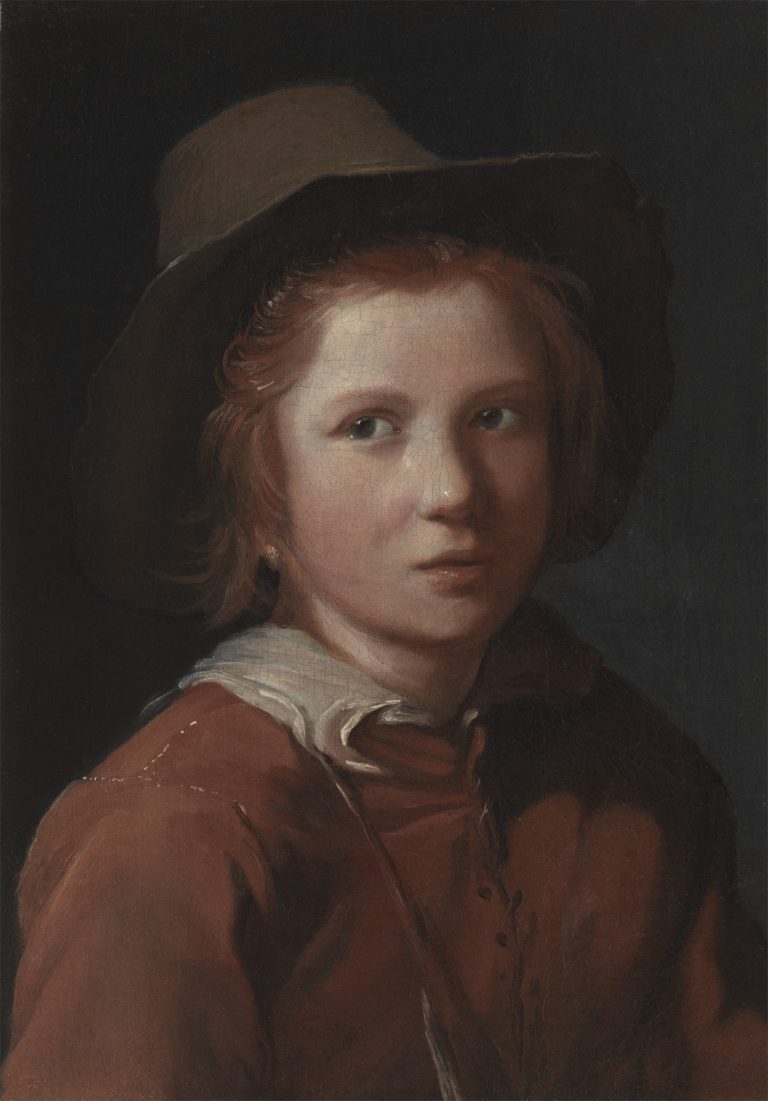Rendered with red and brown earth tones and a light that catches his glistening blue eyes and parted lips, Michael Sweerts’s Portrait of a Young Boy with a Hat evokes the tenderness of boyhood. The figure’s averted gaze and slightly turned shoulders suggest his attention is directed elsewhere, but Sweerts depicted the details of his dress and features with such softness and tactility that he seems strikingly present before the viewer. He wears a slightly tattered, broad-brimmed hat pushed back on his head to expose waves of reddish brown hair accented by his ocher-red jacket. It, too, seems worn, as the light reveals small tears in the seams on his right shoulder. Sweerts manipulated the light to play across the boy’s forehead, cheeks and nose, casting rich shadows along the left side of his face and jagged patterns descending along his arm and torso. Although he appears to be from a lower social class, Sweerts has rendered him with gentle grace.
The lifelike quality of this image suggests that it was done directly from life, or naer het leven, in the Netherlandish tradition of the tronie.1 These head studies, which appear so exacting in their representation that they could be mistaken for formal portraits, were instead highly individualized depictions of anonymous figures. Removed from a specific time or place, tronies gave artists the opportunity to focus on the physical and psychological character of an individual.2 Tronies of young men particularly interested Sweerts after he returned to Brussels in the early to mid-1650s, and Portrait of a Young Boy with a Hat is one of at least five similar images that he executed in that decade.3 While Sweerts also depicted young and old women with a similar degree of sensitivity, his representation of young men was exceptional in the seventeenth century, both in number and discerning manner of execution.4 These works, as evidenced in the Leiden Collection painting, demonstrated Sweerts’s ability to create a pictorial experience both immediate and timeless.
This approach is similarly evident in Sweerts’s Boy with a Hat in Hartford (fig 1).5 The figure wears a similar broad-brimmed hat, though pushed farther down on his head, and a white collared shirt beneath a tattered jacket. As he gazes over his right shoulder, his body recedes sharply back into space. Sweerts repeated this compositional device—the turned head and angled shoulders—in his images of young men from the latter half of the 1650s, including Portrait of a Youth in San Francisco, from ca. 1659–61.6 The somewhat awkward frontal emphasis and tightly cropped composition of the Leiden Collection painting distinguishes it from Sweerts’s other male tronies and suggests that it may have been among the first of this series of tronies that he painted in the mid-1650s.
Sweerts’s tronies may have had a didactic function. In Brussels, Sweerts established a drawing academy for young artists and tapestry designers to learn how to draw a model from life.7 This academic exercise may have been complemented by Sweerts’s own Diversae facies, a print series of various head studies that he published in 1656.8 Following in the tradition of earlier seventeenth-century drawing books, these etchings represented a range of character types for students to copy as part of their training. One such etching from this series, Youth with a Fur-Trimmed Cap (fig 2), shares a number of stylistic and compositional similarities with Portrait of a Young Boy with a Hat. The half-length figure is positioned against an empty background with his head and shoulders turned to the left. Sweerts rendered the figure with a similar use of chiaroscuro, even creating distinct patterns of shadows on his jacket. Although noticeably older than the boy in the Leiden Collection painting, this etching demonstrates how Sweerts was able to modify a range of character types in age, gender, and dress to suit his needs in print or paint. Much as with the etchings, Portrait of a Young Boy with a Hat could have served as a model for Sweerts’s students in the academy.9
Sweerts’s sensitive representation of an individual set against an undefined, dark background shares stylistic similarities with Johannes Vermeer’s (1632–75) Girl with a Pearl Earring (fig 3). The latter work, painted a decade after Sweerts’s image, similarly conveys a timeless, classicizing beauty.10 Although the two artists likely never met, the ability of Sweerts and Vermeer to evoke the spirit of an individual and render him or her, regardless of class, with an unusual sense of dignity reflects a shared artistic sensibility.
